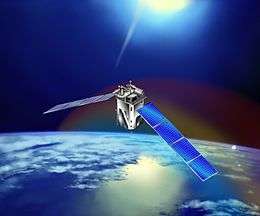TIMED
 TIMED in Low Earth orbit. | |
| Mission type |
Ionosphere Atmospheric science Space weather research. |
|---|---|
| Operator | NASA |
| COSPAR ID | 2001-055B |
| SATCAT № | 26998 |
| Website | TIMED at APL |
| Mission duration |
2 years (planned) 8+ years (ongoing) |
| Spacecraft properties | |
| Manufacturer | Applied Physics Laboratory |
| Launch mass | 660 kilograms (1,460 lb) |
| Power | 300 W (nominal) |
| Start of mission | |
| Launch date | 7 December 2001, 15:07:35 UTC |
| Rocket | Delta II 7920-10 D289 |
| Launch site | Vandenberg SLC-2W |
| Orbital parameters | |
| Reference system | Geocentric |
| Regime | Low Earth |
| Semi-major axis | 6,983.0 kilometers (4,339.0 mi) |
| Eccentricity | 0.0000651 |
| Perigee | 611.7 kilometers (380.1 mi) |
| Apogee | 612.6 kilometers (380.7 mi) |
| Inclination | 74.0722º |
| Period | 96.8 minutes |
| RAAN | 302.7819 degrees |
| Argument of perigee | 343.2534 degrees |
| Mean anomaly | 16.86255 degrees |
| Mean motion | 14.87734465 |
| Epoch | 26 June 2016 |
| Revolution number | 78858 |
The TIMED (Thermosphere Ionosphere Mesosphere Energetics and Dynamics) is an orbiter mission dedicated to study the dynamics of the Mesosphere and Lower Thermosphere (MLT) portion of the Earth's atmosphere. The mission was launched from Vandenberg Air Force Base in California on December 7, 2001 aboard a Delta II rocket launch vehicle. The project is sponsored and managed by NASA, while the spacecraft was designed and assembled by the Applied Physics Laboratory at Johns Hopkins University. The mission has been extended several times, and has now collected data over an entire solar cycle, which helps in its goal to differentiate the Sun's effects on the atmosphere from other effects.[1]
Atmospheric region under study

The Mesosphere and Lower Thermosphere (MLT) region of the atmosphere to be studied by TIMED is located between 60–180 km above the Earth's surface where energy from solar radiation is first deposited into the atmosphere. This can have profound effects on Earth's upper atmospheric regions, particularly during the peak of the Sun's 11-year solar cycle when the greatest amounts of its energy are being released. Understanding these interactions is also important for our understanding of various subjects in geophysics, meteorology, and atmospheric science, as solar radiation is one of the primary driving forces behind atmospheric tides. Changes in the MLT can also affect modern satellite and radio telecommunications.
Scientific instruments onboard
The spacecraft payload consists of the following four main instruments:
- Global Ultraviolet Imager (GUVI): A spatial-scanning, far-ultraviolet spectrograph designed to globally measure the composition and temperature profiles of the MLT region, as well as its auroral energy inputs.
- Solar Extreme Ultraviolet Experiment (SEE): A spectrometer and a suite of photometers designed to measure the solar soft X-rays, extreme-ultraviolet and far-ultraviolet radiation that is deposited into the MLT region.
- TIMED Doppler Interferometer (TIDI): Designed to globally measure the wind and temperature profiles of the MLT region.
- Sounding of the Atmosphere using Broadband Emission Radiometry (SABER): Multichannel radiometer designed to measure heat emitted by the atmosphere over a broad altitude and spectral range, as well as global temperature profiles and sources of atmospheric cooling.
Spacecraft stats
- Mass: 660 kilograms
- Dimensions:
- 2.72 meters high
- 1.61 meters wide (launch configuration)
- 11.73 meters wide (solar arrays deployed)
- 1.2 meters deep
- Power Consumption: 406 watts per orbit
- Data Downlink: 4 megabits per second
- Memory: 5 gigabits
- Control & Data Handling Processor: Mongoose-V
- Attitude:
- Control - Within 0.5 degrees
- Knowledge - Within 0.03 degrees
- Processor: RTX2010
- Total Mission Cost:
- Spacecraft: $195 million
- Ground Operations: $42 million
United States
- University of Alaska, Fairbanks, Alaska
- University of California, Berkeley, California
- Jet Propulsion Laboratory, Pasadena, California
- University of Colorado, Boulder, Colorado
- National Center for Atmospheric Research, Boulder, Colorado
- National Oceanic and Atmospheric Administration, Boulder, Colorado
- The Johns Hopkins University Applied Physics Laboratory, Laurel, Maryland
- Air Force Research Laboratory, Hanscom Air Force Base, Massachusetts
- Stewart Radiance Laboratory, Bedford, Massachusetts
- University of Michigan, Ann Arbor, Michigan
- Southwest Research Institute, San Antonio, Texas
- Utah State University, Logan, Utah
- Hampton University, Hampton, Virginia
- Computational Physics, Inc., Fairfax, Virginia
- Naval Research Laboratory, Washington, D.C.
- NASA Langley Research Center, Hampton, Virginia
- G&A Technical Software Inc., Hampton, Virginia
International
- Hovemere Limited, Kent, England, United Kingdom
- British Antarctic Survey, Cambridge, England, United Kingdom
- CREES-York University, Toronto, Canada
- Astrophysical Institute of Andalucia (IAA), Granada, Spain
- Rostock University, Rostock, Germany
See also
References
- ↑ Fox, Karen. "Ten Successful Years of Mapping the Middle Atmosphere". NASA.
External links
- TIMED mission page at JHU/APL
- TIMED mission page at NASA GSFC
- Solar EUV Experiment (SEE) page at the Laboratory for Atmospheric and Space Physics